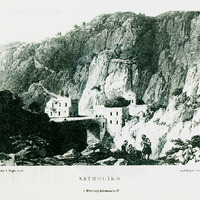Μονή Καθολικού
Αντικείμενο
Τίτλος Σημείου Ενδιαφέροντος
el
Μονή Καθολικού
en
Katholiko monastery
Περιγραφή / Απόσπασμα
74
en
At a distance of half a mile from the cave is a secluded spot in which the deserted monastery of Katholikó is situated.
Παρατηρήσεις
el
Ο Pashley θεωρεί τη μονή ως το καταλληλότερο μέρος ασκητισμού από όλες τις μονές που έχει επσικεφτεί.
en
Pashley considers the convent to be the most suitable place for asceticism of all the monasteries he has visited.
Σύγχρονη περιγραφή
el
Η Μονή Καθολικού ή Μονή Αγίου Ιωάννη του Ερημίτη βρίσκεται 20χλμ βορειοανατολικά των Χανίων. Το μοναστικό συγκρότημα ιδρύθηκε στο σημείο όπου βρίσκεται το σπήλαιο που κοιμήθηκε ο Άγιος Ιωάννης ο Ερημίτης ή Ξένος κατά τον 11ο αιώνα και θεωρείται ότι είναι το παλαιότερο της Κρήτης. Μετά το θάνατο του Αγίου Ιωάννη του Ξένου αυτή η δύσβατη περιοχή, που είναι γνωστή ως Αρκουδοβούνια, μετατράπηκε σε ένα από τα σπουδαιότερα κέντρα ασκητισμού στην Κρήτη. Η σπηλιά που κοιμήθηκε έγινε ναός και οι τριγύρω κοιλότητες αποτέλεσαν αρχικά καταφύγιο για τους ερημίτες, ενώ αργότερα κτίστηκαν και μερικά κελιά. Το μοναστικό συγκρότημα απέκτησε τη σημερινή εντυπωσιακή του μορφή όταν τον 17ο αιώνα, μπροστά από το σπήλαιο, έγινε μια εκτεταμένη οικοδόμηση κτισμάτων, υπό την επίβλεψη του Ιερεμία Τζαγκαρόλου, με αρχιτεκτονικά σχέδια από τα έργα του Sebastiano Serlio. Η λατρεία του Αγίου Ιωάννη είχε διαδοθεί τόσο πολύ στην ευρύτερη περιοχή των Χανίων, που κατά την απογραφή του 1637 τα έσοδα από τους προσκυνητές ήταν από τα μεγαλύτερα. Στο χώρο διακρίνονται ακόμη τα ερειπωμένα κελιά των ασκητών, το καμπαναριό και η εντυπωσιακή γέφυρα που διασχίζει τον ποταμό του φαραγγιού. Όταν οι ακτές της Κρήτης μπήκαν στο στόχαστρο των πειρατών της Μεσογείου ο φόβος κυριάρχησε, το μοναστήρι ερήμωσε και οι μοναχοί αναγκάστηκαν να μεταφερθούν σε ένα πιο απόμερο μέρος κι έτσι αποσύρθηκαν στη μονή Γουβερνέτου. Στην έξοδο του φαραγγιού στη θάλασσα υπάρχει κι ένας μεγάλος βράχος που μοιάζει με καράβι και, σύμφωνα με το θρύλο, είναι ένα πειρατικό καράβι που πέτρωσε μετά από τις κατάρες του ηγούμενου του Καθολικού.
en
The Monastery of Katholiko or Monastery of Agios Ioannis the Hermit is situated 20 km to the northeast from Hania. The monastery complex was founded at the spot where the cave that Agios Ioannis the Hermit or Foreigner slept in during the 11th century and is considered to be the oldest of Crete. Upon the death of Agios Ioannis the Foreigner, this rocky area, also known as Arkoudovounia, was transformed into one of the greatest centers of ascetism in Crete. The cave he slept in became a temple, and the cavities nearby became initially a refuge for hermits, while a few cells were also built later on. The monastery complex took its impressive current form, when, in the 17th century, at the front of the cave, an extended construction of buildings took place, under the supervision of Jeremiah Tsangarolo, with architectural designs taken by the works of Sebastiano Serlio. The worship of Agios Ioannis was so widespread in the greater Hania area, that during the census of 1637, the revenues from pilgrims were the largest. At the area you may still spot the abandoned cells of the ascetes, the bell tower and the impressive bridge that crosses the river of the canyon. When the shores of Crete entered the line of fire of the pirates of the Mediterranean, fear prevailed, the monastery was abandoned and the monks had to be transferred to a more secluded area, thus going to the monastery of Gouverneto. At the exit of the canyon to the sea, there is also a big rock that resembles a ship and, according to the legends, it used to be a pirate ship that turned to stone after the curses of the abbot of Katholiko.




